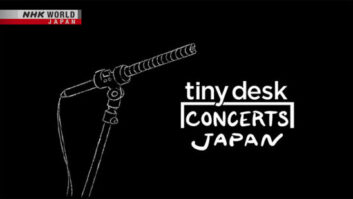
Marty Garrison Marty Garrison enjoys leading people across treacherous terrain. He fulfilled that ambition for many years as a climbing guide on Yosemite’s famous rock faces El Capitan and Half Dome.
He also likes leading the construction of large broadcast and IT/data facilities, as he’s done for several large organizations including Turner Broadcasting System.
These qualities made him a perfect fit when he joined NPR in 2010 as vice president of technology operations, distribution and broadcast engineering — essentially, NPR’s CTO — just as the big public radio organization was about to dig dirt for a new headquarters in Washington.
Garrison is recipient of the 2013 Radio World Excellence in Engineering Award. Recipients represent the highest ideals of the U.S. radio broadcast engineering profession and reflect those ideals through contributions to the industry.
‘CRITICAL’ LEADERSHIP
You may not know his name yet because he’s relatively new to radio; but Garrison holds one of the premier radio engineering management jobs.
He heads the technical team that ensures that NPR programming gets on the air and is distributed nationally and globally. The team must keep 17 bureaus going and is responsible for the integrity and technical quality of all its shows. His staff oversees NPR Satellite Services, which handles distribution for virtually all public radio programming in the United States; customers include American Public Media and Public Radio International, which also produce national public radio programming.
And the department is responsible for traditional back-office IT services at NPR including financial and development systems, email, voice and a worldwide data network. With approximately 200 employees, it is the second largest department at NPR, after news.
Garrison supervised the move of these technical operations to new headquarters at 1111 North Capitol Street in Washington’s NoMa neighborhood, including a new 55,000-square-foot newsroom, new studios and technology and distribution centers that support iconic programs such as “All Things Considered” and “Morning Edition.” The move was completed this year.
He and the staff that you see in the accompanying group photo were responsible for facilitating one of the highest-profile radio build-outs in North America. The project demanded meticulous coordination, a vast amount of detail work and a move that had to be planned down to the minute, even the second.
By all accounts it was a successful transition; the job even was completed earlier than scheduled, and created a showcase in the nation’s capital for the best that public radio has to offer.
His boss, NPR Chief Administrative Officer Joyce Slocum, told Radio World, “Marty’s leadership was critical to achieving the rare result of delivering a project of this magnitude and complexity ahead of schedule and under budget, and to the satisfaction of all constituencies. From production studios for our programming, to computers and telephones for our support staff, to the satellite system for distribution to public radio stations, Marty’s teams worked together to ensure that everything functioned smoothly from the first moment.”
It was not Garrison’s first technical project involving aggressive timeframes and large capital budgets. He was senior vice president of global technical operations for Turner Broadcasting and has held technical management leadership positions with Thomson Reuters, British Petroleum and other companies.
Like many of the engineers we’ve honored, his career merges traditional broadcast considerations with new media platforms, data networks and IT infrastructure, exemplifying the evolving skills needed to lead multimedia organizations.
Garrison is the second NPR recipient of our award; Michael Starling, currently executive director of NPR’s Technology Research Center and NPR Labs, received it in 2005. Last year’s recipient was Paul Brenner of Emmis Communications.
DATA CENTERS
Garrison grew up in information technology. He worked for BP as an Oracle database administrator in the early 1980s. In 1992 he built his first data centers for Ingres Corp. in London and Dublin, his initial foray into construction.

The technical project team in front of the building after the move to 1111 North Capitol Street, NE. They called themselves TDIG, the Technical Design and Implementation Group. Turner soon hired him as director of domestic technical operations and not long thereafter transferred him to London as VP of international information technology, responsible for all aspects of technology service delivery for TBS locations outside the United States.
His biggest job at Turner came when he returned to this country as senior VP of global technical operations.
Broadcast was finally catching up and moving from analog to digital. “We were getting rid of big tape devices and moving essentially to media servers, non-linear editing.” Turner recognized this convergence and offered him a job to keep the portfolio of broadcast infrastructure but also merge the broadcasting engineering infrastructure of CNN into that operation.
“It was the biggest challenge of my career because I didn’t really understand broadcast video technology. I had to learn that while winning the confidence and trust of several hundred traditional broadcast engineers, and bring them along into the digital world.”
It was a fascinating time, with digital media servers entering an environment where most engineers didn’t even have computers on their desks — if they had desks at all, not workbenches.
He led a large consolidation of facilities in Hong Kong that involved Warner Bros., Time Inc., Turner and CNN operations. He subsequently ran a similar project in New York, moving multiple businesses into the Time Warner Center on Columbus Circle. That project required $30 million of infrastructure investments including one of the first large-scale cross-vendor deployments of VoIP using Cisco network components and Avaya VoIP systems. It was a three-year job during which he commuted from Atlanta three days a week.
The Turner position, he said, “was a heckuva lotta fun, and it positioned me so well for this job later in my career.” Later, at Thomson Reuters in Minneapolis, he and his team of about 1,000 people built a data center every 18 months. So projects involving large buildings and data operations were becoming commonplace for him.
He was working there when a recruiter called about the NPR project.
TEAM JOB
Make no mistake; the headquarters move was a team effort. Garrison talks about the strong staff in NPR audio and distribution, engineers who perhaps had not built a project of this scale before but had plenty of advanced tech experience. They worked side by side with a relatively younger IT group that hadn’t built big radio infrastructure but whose role was critical because practically everything in the building runs on the IT network.
“It’s about herding cats,” Garrison joked. “It was about getting everyone to row in the same direction at the same time, and winning the confidence of some very seasoned engineering professionals, and giving confidence to a traditional technology organization that they could pull this off.”
Parts of the move had to be planned very closely. “What gave me the most worry was not building this facility. It was moving a 7×24 radio production operation and a 7×24 distribution system with no down time.”
While the new building was under construction a few blocks away, the tech team built a duplicate of NPR’s distribution system, the infrastructure that distributes public radio content for producers and stations, including multiple dishes and antennas on the roof.
The staff built the new system first in a building next to the old headquarters at 635 Massachusetts Avenue. They tested the system for months. When the tech core of the new site at 1111 North Capitol was ready, they timed its disassembly, moved it and rebuilt the distribution system, then tested it again.
Scope of the Job
A brief description of the technical infrastructure involved in the NPR move.
Audio — Broadcast engineering’s side of NPR’s building project comprised the build and installation of three broadcast studios, 10 production studios, six production booths, a high-end recording/events space and a centralized technical logistics center. Using digital technologies provided by Lawo North America, facilities are connected via a fiber network that runs on NPR’s corporate network, and protected by multiple secure VLans to a secure centralized Technical Core. Two redundant core audio routers are the Lawo HD73 HDs with controlling software provided by VSM. Besides basic audio routing functionally, software is configured to automatically restore NPR core programming to member stations with three separate backup audio sources after 12 seconds of silence is detected from the primary source. Audio peripherals include Genelec monitors, Neumann U87 microphones, Tascam CD players and NPR’s own asset management System NewsFlex, integrated with audio recording and playback software from DAVID Systems. HA Design Group was the systems integrator. Studio design and architectural services were provided by Bloomfield & Associates. Shen Milsom & Wilke provided acoustical design services. Studio furniture was designed by Bloomfield & Associates and constructed by Studio Technology.
Distribution — The Public Radio Satellite System, managed by NPR, outfitted all of the system’s 400-plus interconnected stations with new IDC SFX 4104 satellite receivers. As part of the buildout of the PRSS’ Network Operations Center in the headquarters building, engineers installed an upgraded audio routing system utilizing Axia routing technology. The Axia switch incorporates a design that can accommodate 2,025 destinations and 1,012 sources. System monitoring was enhanced using Evertz Microsystems products to manage a video-display wall. The wall uses Ethernet packets and other proprietary MIBS to display readings on encoders, modulators and encapsulators, RF equipment and other carrier measurement tools.
IT — NPR installed an Avaya Aura PBX in the new building in Washington. The Aura platform offers a hybrid solution. Studio and production facilities are populated with TDM phones to provide a higher call quality and greater reliability. A large percentage of NPR audio is still transported using legacy technology such as analog and ISDN BRI. All TDM gateways have redundant power and processors. Staff phones are provided as part of an IP-based solution; they are deployed in one of two configurations. The general population has a Cat-6 that supplies both phone and data; staff that edit audio have separate data feeds for computer and data. Likewise, trunking is a hybrid. NPR uses a mix of traditional T1 PRI, analog loop start and SIP trunking. For the production data network, NPR built an all-Cisco network using the Cisco Nexus series, with FabricPath technology.
“At 12:59:10 p.m. on April 1, we pulled the trigger and seamlessly starting broadcasting all public radio in the United States out of 1111 without a hitch,” Garrison recalled. The feeling? “Goosebumps. We were all in the NOC — the CEO, a lot of people.”
Back-office and support groups such as finance, accounting and legal were moved over; studio shows transitioned on a staggered schedule to minimize disruption.
But this being radio, something unexpected could be, well, expected.
As the search for the Boston Marathon bombing suspects reached its climax, the production team handling coverage was working at 1111 but the “Morning Edition” operation was still in its old location. On Friday April 19 — the day Dzhokhar Tsarnaev was found hiding in the boat — “Morning Edition” host David Greene got in his car and drove over to the new studio location while Steve Inskeep continued on the air. Inskeep came over later. Thus the most-listened-to radio news program in the country could continue its expanded coverage of this national story without an audible hitch.
The total building cost was around $243 million, of which $31 million involved the technical aspects. The project came in slightly under budget and was delivered three months ahead of schedule. NPR saved a lot of money by limiting the cost of dual occupancy.
SATISFACTION
Garrison is a native of northern California. He has a Bachelor of Science in earth sciences from the University of California, Santa Cruz. He doesn’t rock climb anymore but he’s an avid cyclist at age 57. He resides with his wife Vanessa in Washington.
Having now worked on at least nine big-scale technology infrastructure projects in Washington, Hong Kong, London, Atlanta and New York, Garrison believes such jobs require skill and tenacity, to work with the aggressive timescales and pressures of a live broadcast environment. Sometimes decisions need to be made quickly and assertively.
“You’re dealing with unions, with technology decisions, with taking risks, with planning moves. It’s fascinating stuff. I love this job. I love the company. I love building organizations, or transforming organizations. And I just happen to love doing these buildings.”
Garrison, 57, also enjoys the satisfaction that his teams feel, especially the less experienced ones. “I have some grey hairs [but] I try to describe to these younger employees how they’ll feel when they walk by that building a few years from now and say, ‘I was part of that.’”
Comment on this or any story. Email [email protected].












